Lefteye Flounders: Family Bothidae
Species: Paralichthys californicus (Ayres, 1859); from the Greek word paralichthys (parallel fish) and californicus (Californian)—a California fish that lies parallel to the bottom.
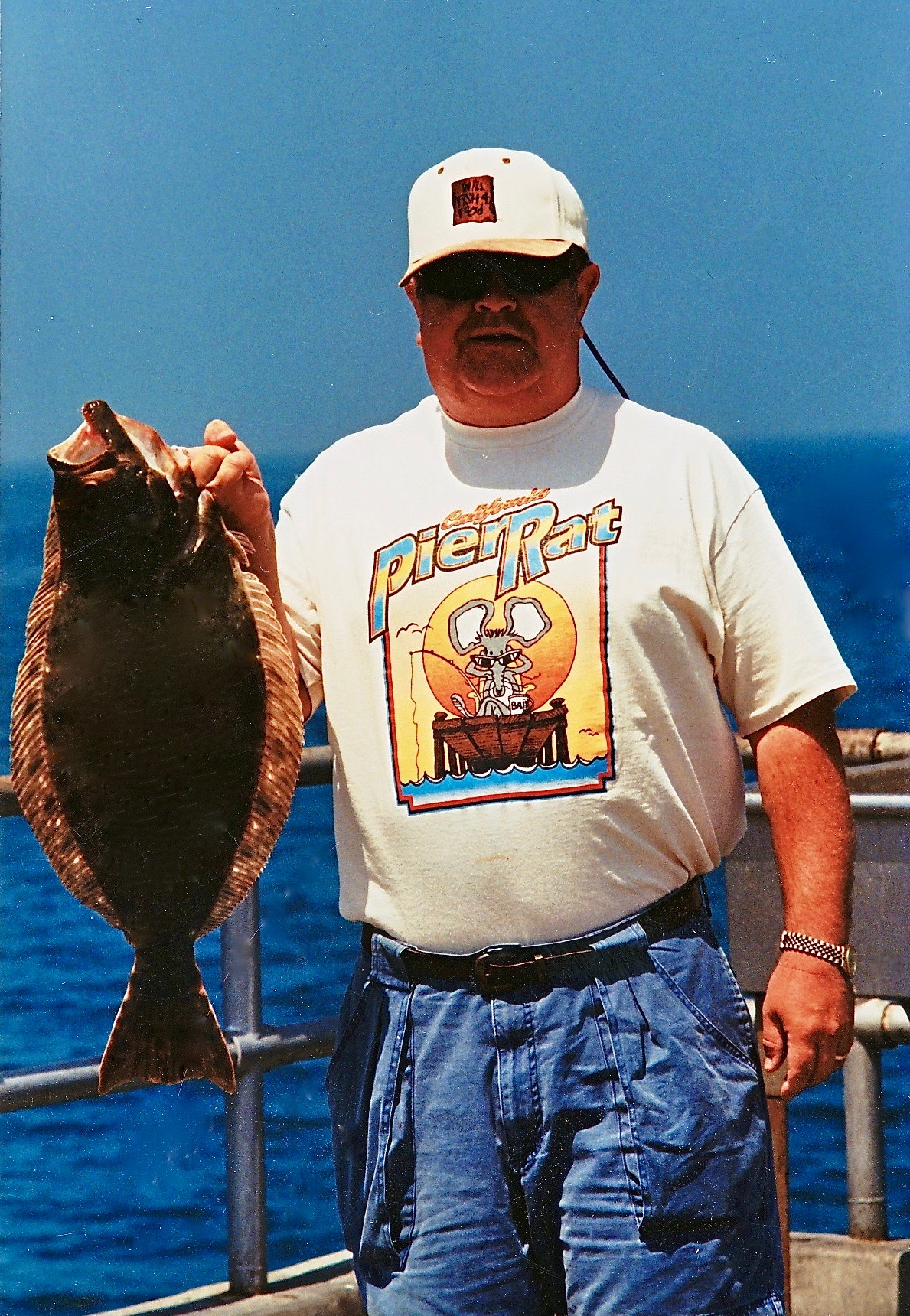
Halibut taken by KJ at the Balboa Pier
Alternate Names: Halibut, flounder, hali, flattie (or flatty), chicken halibut, alabato, southern halibut, Monterey halibut, bastard halibut; fly swatter or postage stamp (small halibut); door mats (large halibut); extra large halibut, rarely seen on piers, are called barn doors. Called lenguado de California in Mexico.
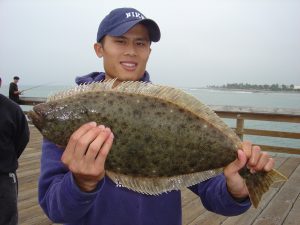
Halibut caught at the Ventura Pier
Identification: California halibut are in the left-eye flounder family, although nearly half of these fish are right-eyed. Halibut are noted for their sharp teeth, a large squarish shaped mouth, and a high arch in the lateral line above the pectoral fin. Their coloring is normally white or yellowish on the blind side and a muddy brown on the colored side. Often there is splotching or even white spots on the colored side, especially in smaller fish.
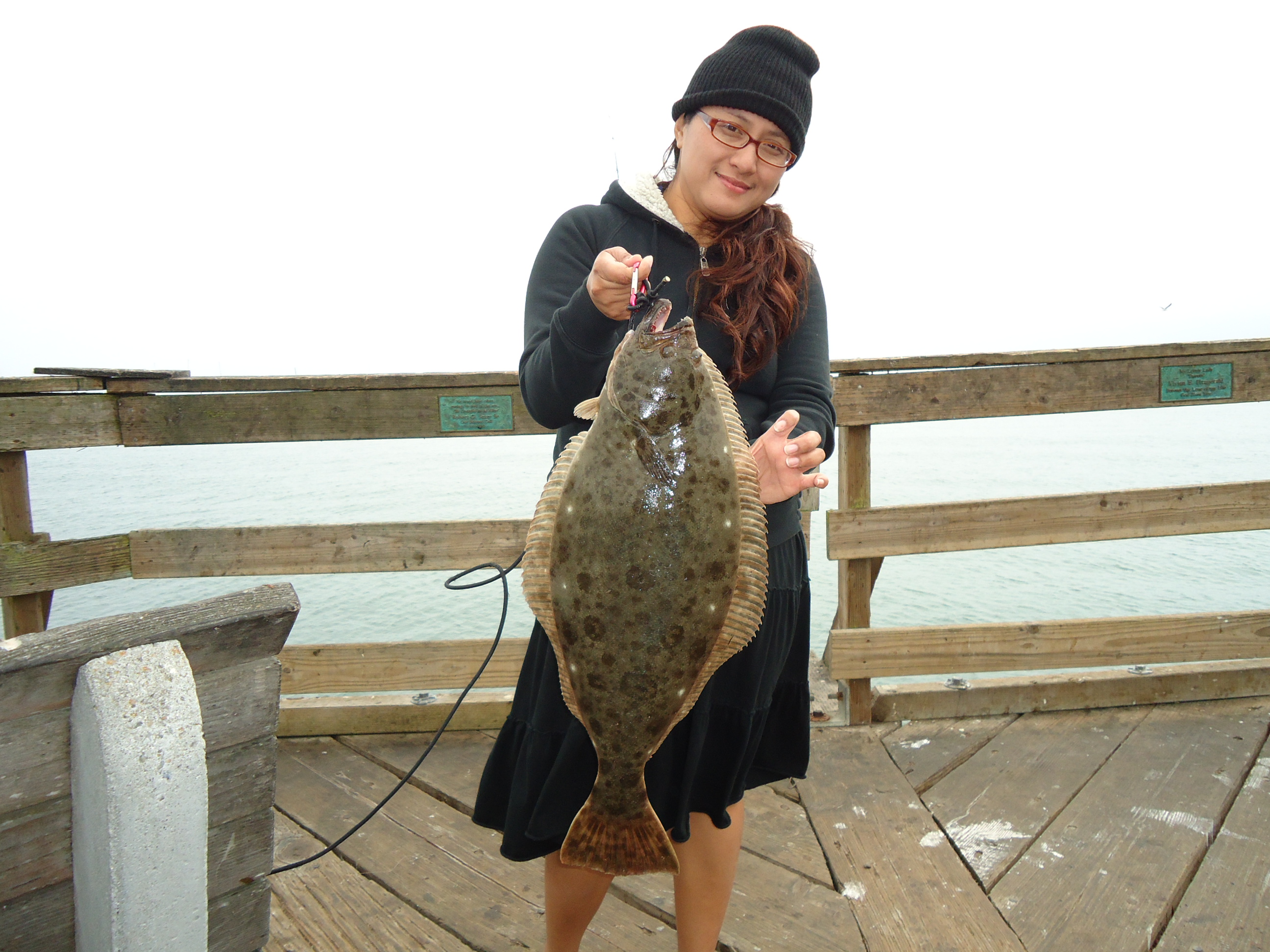
Halibut from the Capitola Wharf — Picture courtesy of Capitola Bait & Tackle store
Size: To 60 inches and 72 pounds; most caught from piers are under 20 inches. The California angling record fish weighed 67 Lbs 4 oz and was caught at Santa Rosa Island in 1999. The diving record is 72 Lbs 8 oz for a fish taken at Santa Cruz Island in 1982.
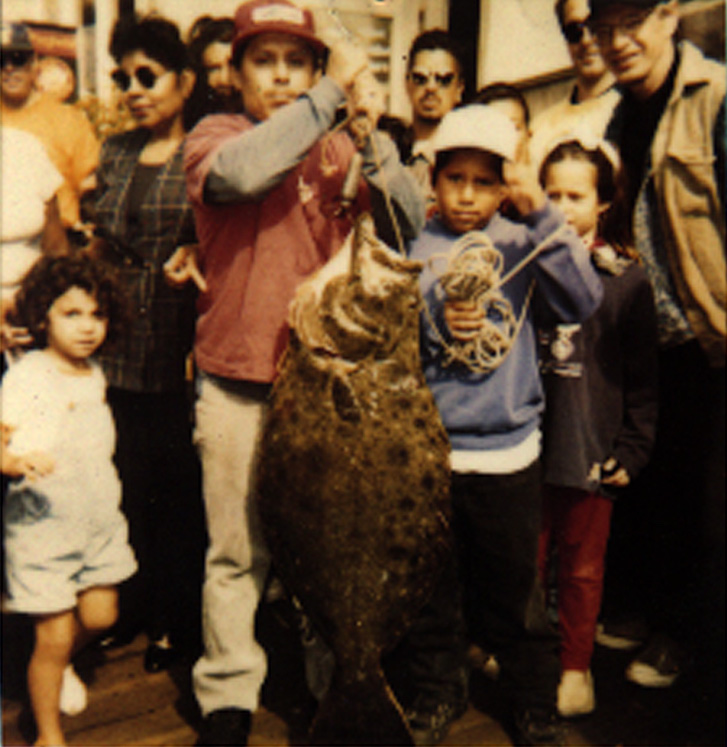
Halibut caught by “Luis” in 1997 at the Santa Monica Pier — measured at 40 inches
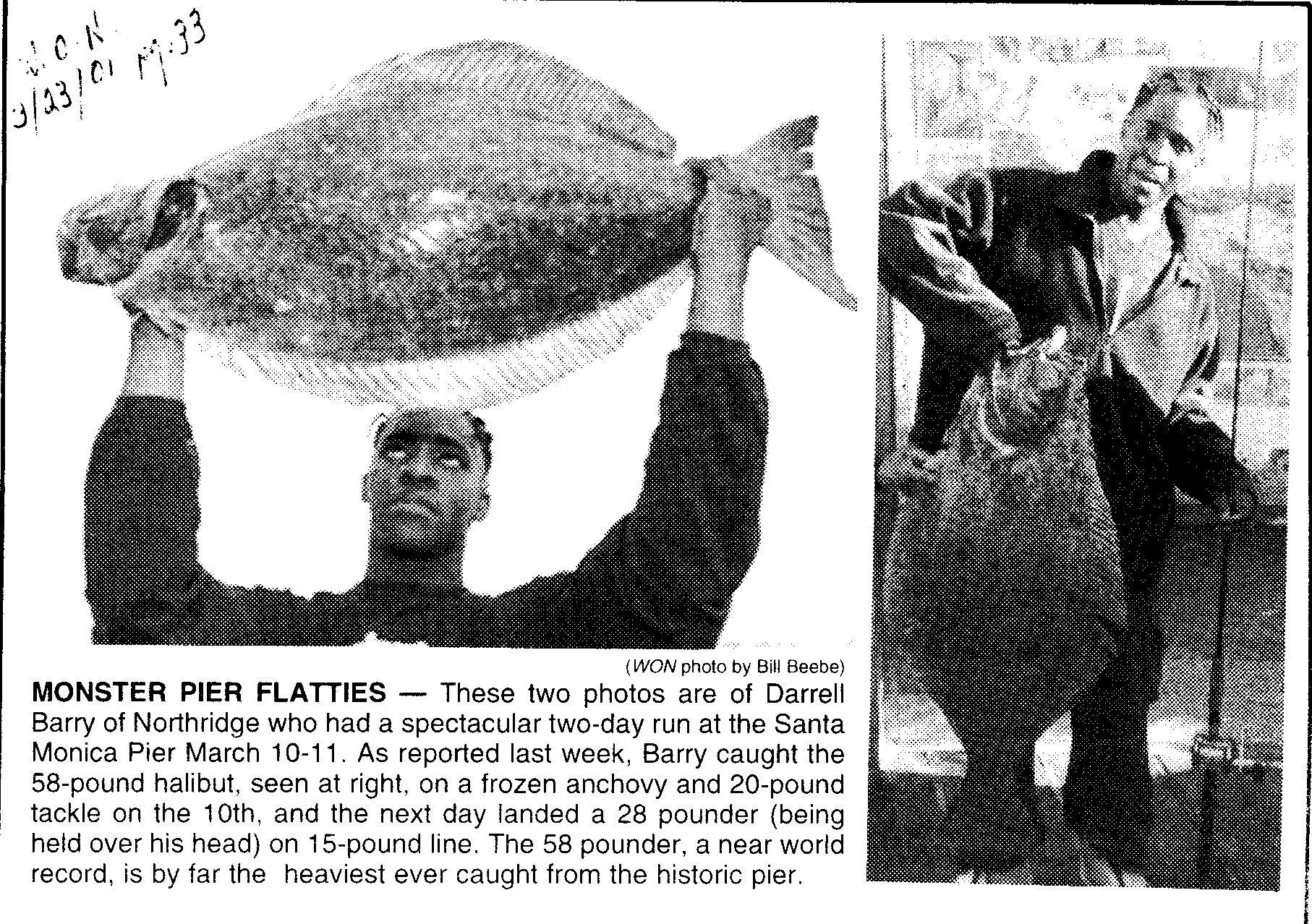
Two large halibut taken from the Santa Monica Pier
Range: Gulf of California and Cabo Falsa, southern Baja California to Quillayute River, northern Washington. Common from southern Baja California to Tomales Bay, northern California.
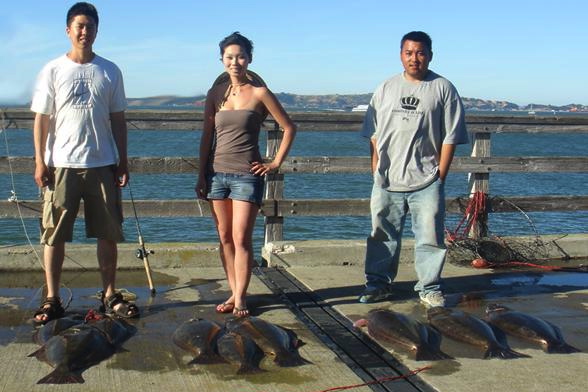
A nice catch of halibut from the Paradise Beach Pier
Habitat: Found in both ocean and bay waters from the surf zone down to a depth of 1,040 feet.
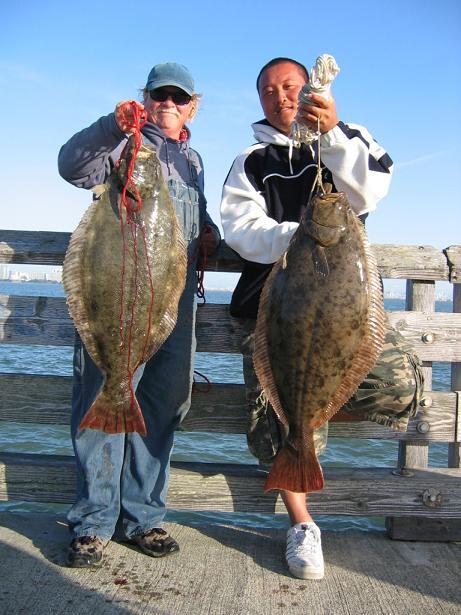
Halibut taken from the Berkeley Pier by Songslinger and CalRat
Piers: Most common at oceanfront piers. Best bets: Crystal Pier, Oceanside Pier, Balboa Pier, Redondo Beach Pier, Hermosa Beach Pier, Goleta Pier and Cayucos Pier. A few are caught each year at Monterey Bay piers such as Capitola and Seacliff. An increasing number since the ’90s have been caught at Pacifica and at San Francisco Bay piers such as Pier 7 in San Francisco and the Berkeley Pier. The Berkeley Pier (when open) probably ranked #1 among piers north of Point Conception and generally saw more large halibut than any other pier in the state.
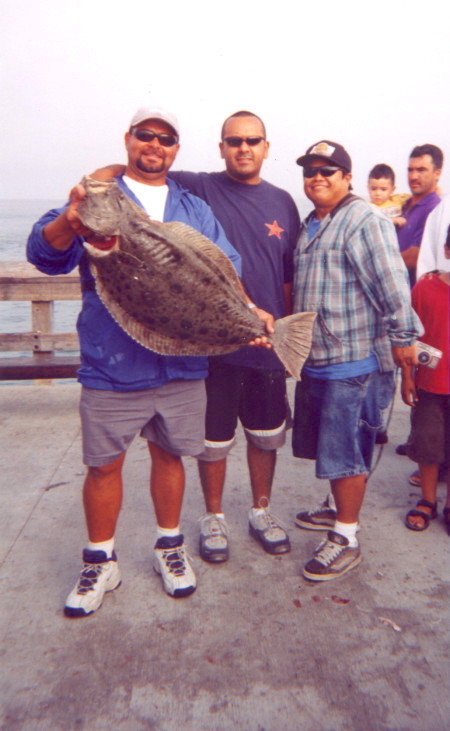
Halibut taken from the Newport Pier by Humberto Morno
Shoreline: An esteemed shore species from San Diego to San Francisco.
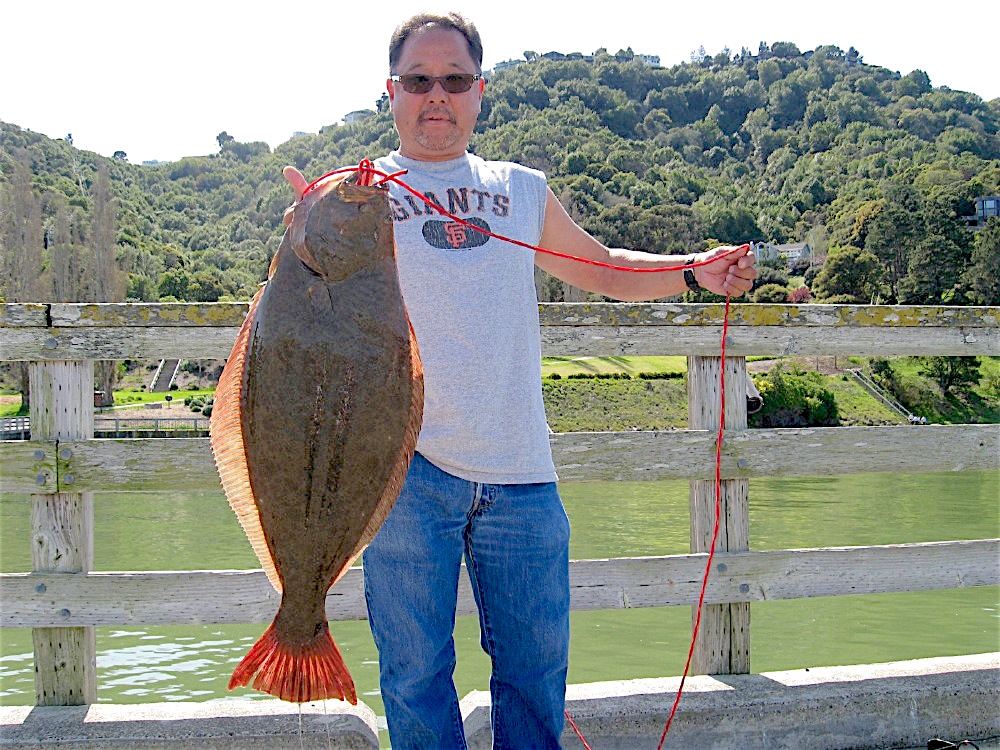
A halibut caught by Mel from the Paradise Beach Pier
Boats: One of the favorite species for California boat anglers.
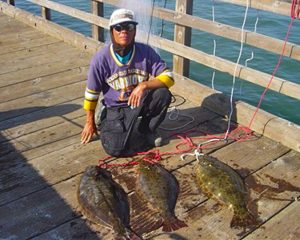
A trio of halibut taken by “Stan the Man” at the Candlestick Point Pier
Bait and Tackle: Halibut are predatory hunters that will sometimes grab almost anything that moves. Still, they prefer other fish—anchovies, sardines, grunion, smelt, small brownbait (queenfish and white croaker), small perch (shinerperch and walleyes), Spanish and Pacific mackerel, Pacific butterfish (pompano), lizardfish and squid. If the fish will fit in their mouth they’ll go after it. Thus, by far, the best bait for California halibut is live bait, one of those fish mentioned previously. Whichever bait is used, the key is to keep it lively and keep it near the bottom. A sliding live bait leader works fine, especially with a small slip-on sinker added to get the bait near the bottom. Another approach is to use a Carolina rigging. Take an egg sinker (that has a hole through the middle of it) and run your line through the sinker. Next, tie a snap-swivel to the end of your line (after adding a couple of red beads above the snap-swivel to help attract fish and protect the knot from abrasion). Then attach a three to four foot leader with size 2 to 4 hooks to the snap. High/low leaders can also be used but are generally less effective unless the angler keeps his line in motion.
Some regulars “drag” or “troll” for halibut: they put a long-shanked hook into a headless anchovy and then walk slowly along the edge of the pier pulling the line behind them. If the pier is crowded, they will cast out and retrieve slowly. In either case, be alert for the soft mouthing of the halibut. Halibut will hit cut bait, including anchovies, mackerel, sardine and even squid; just be sure to keep the bait in motion.
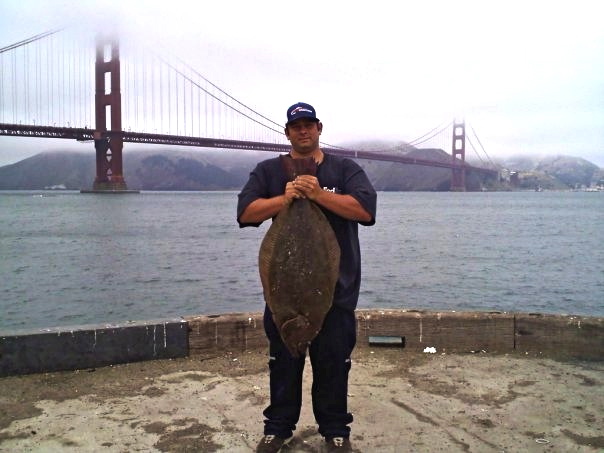
38-inch halibut taken at the Fort Point Pier
Some regulars “drag” or “troll” for halibut: they put a long-shanked hook into a headless anchovy and then walk slowly along the edge of the pier pulling the line behind them. If the pier is crowded, they will cast out and retrieve slowly. In either case, be alert for the soft mouthing of the halibut. Halibut will hit cut bait, including anchovies, mackerel, sardine and even squid; just be sure to keep the bait in motion.
Halibut can also be caught on artificial lures. A variety of lures can also be used to take them, everything from soft plastics like Big Hammers and Zoom Flukes, to shiny spoons like Krocodiles, and even crankbaits. Probably the most popular lure recently has been the Lucky Craft lures, expensive but good. In most cases though lures are less effective from a pier high off the water than when used by those fishing close to the water, i.e., in the surf. Halibut will often follow the lure almost to the surface before striking, so be prepared.
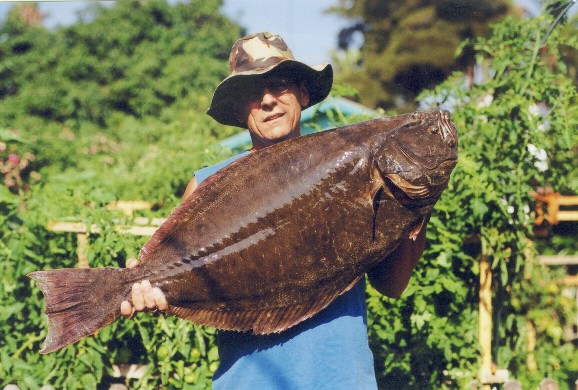
Halibut taken by “Uncle Ted” from the Berkeley Pier
Food Value: Excellent! One of the best tasting fish in our waters. White, mild flavored flesh that is large flaked, soft in texture, and low in fat content. One of the best frying fish although considered good eating using almost any method of cooking. However, be careful not to over cook the meat, which dries it out.
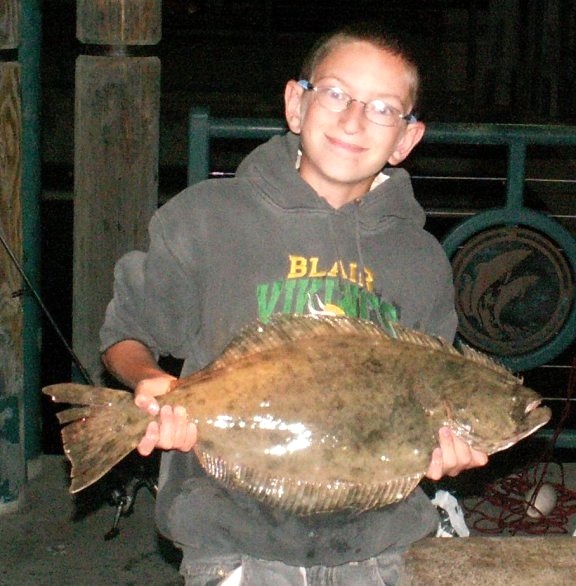
Daniel’s first halibut from the Redondo Beach Pier
Comments: Probably the most sought after fish for anglers on southern California piers. Unfortunately, most of the fish caught in the southland are illegal size and far too many people do not know, or do not care, how to handle them properly. The best way is to quickly reel in or handline in the fish without a net (if possible) and then practice C&R (catch-and-release) or CPR (catch-photograph-release) with as little handling of the fish as necessary. If you’re going to net the fish try to find a net with fine mesh. If you use the typical wide-mesh net the net will often tear up the tail of the halibut leading to infection (tail rot) and eventual death. If you have a fine-mesh net, then the best way to handle the halibut is to net it, bring it up, unhook it, place it back in the net, and lower it back down. It sounds like a lot of work but it’s worth it to preserve these fish and they can live to an age of at least 30 years.
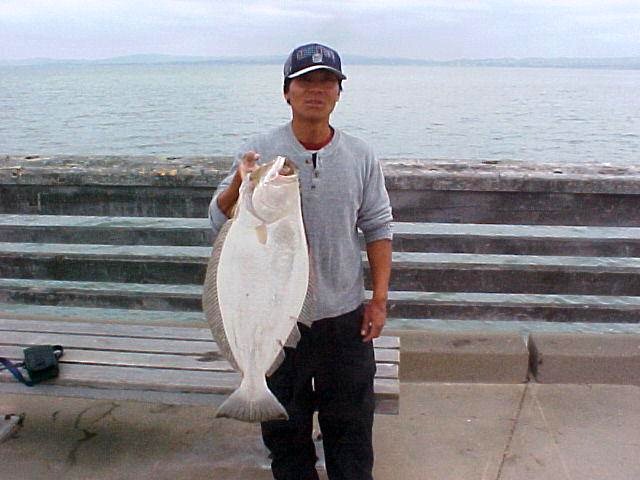
“Stan The Man” and a halibut from the Point Pinole Pier
Do be careful of the sharp teeth of these fish! One guidebook jokingly tells the way to differentiate between small halibut and sole or sanddab: “stick your finger in its mouth. If your finger starts bleeding in a relatively short period of time (don’t keep it there for hours), you probably have a halibut.” DON’T DO THIS!
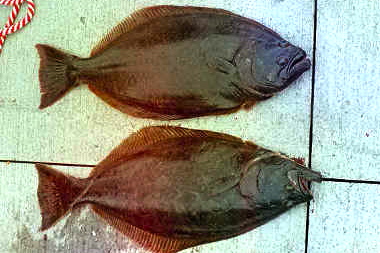
Right-eyed (top) and left-eyed (bottom) California halibut from the Balboa Pier
Unofficial list of “Large” halibut caught from piers
62 ¼ lbs. — Long Wharf (Santa Monica), August 17, 1917
Source: Port of Los Angeles, A Phenomenon of the Railroad Era, Ernest Marquez, 1975
58 Lbs. 11 Oz — Santa Monica Pier, Darrell Barry, March 10, 2001
Source: Several including Santa Monica Pier Bait Shop, PFIC and Western Outdoor News, March 23, 2001
57 Lbs. 30 oz. — Port Hueneme Pier, Joseph C, Groth, Sr., February 28, 1965
Source: Pasadena Independent, March 4, 1965
54 Lbs. — Huntington Beach Pier, W. S. Keith & H. C. Carmichael, May 4, 1939
Source: Santa Ana Register, May 5, 1939
≈ 50 Lbs. — Santa Cruz Wharf, Unknown angler, January 4, 1940
Source: Santa Cruz Sentinel, January 5, 1940
49 ½ Lbs. — Seacliff Pier, Unknown angler, July 2, 1948
Source: Santa Cruz Sentinel, July 4, 1949
48 Lbs. — Long Wharf (Santa Monica), Charles A. Sheldrick, June 26, 1902
Source: Los Angeles Times, June 27, 1902
47 Lbs. — Capitola Wharf, May 19, 1934
Source: Santa Cruz Sentinel, May 20, 1934
45 ¾ lbs. — Balboa Pier, Harry Campbell, May 20, 1927
Source: Santa Ana Register, May 21, 1927
45 ½ Lbs. — Redondo Beach Pier, Virginia Lively, June 24, 1975
Source: Long Beach Independent, July 2, 1975
45+ Lbs. — Capitola Wharf, June 28, 1930
Source: Santa Cruz Evening News, June 30m 1930
45 Lbs. — Seacliff Pier (Aptos), Jack Elliott, July 1, 1946
Source: Santa Cruz Sentinel, July 2, 1946
44 Lbs. — Monterey Wharf No. 2, Neil Dow, September 1, 1939
Source: Santa Cruz Sentinel, September 1, 1939
44 Lbs. — Huntington Beach Pier, Seymore Wilson, June 1933
Source: Santa Ana Register, June 5, 1933
44 Lbs. — Newport Pier, R. O. Stull, July 29, 1931
Source: Santa Ana Register, July 29, 1931
43 Lbs. — Capitola Wharf, Wilbur Boyea, May 14, 1934
Source: Santa Cruz Sentinel, May 16, 1934
42 Lbs. — Cayucos Pier, Ruby Clark, July 17, 1968
Source: Fresno Bee, July 18, 1968
41 lbs. — Santa Monica Pier, Hoyt Holdridge, March 1957
Source: San Bernardino County Sun, March 5, 1957
41 Lbs. — Seacliff Pier, May 17, 1953
Source: Santa Cruz Sentinel, May 20, 1953
41 Lbs. — Hermosa Beach Pier, Mike Mattos, June 1936
Source: Los Angeles Times, June 21, 1936
40+ Lbs. (Two)—Santa Cruz Municipal Wharf, August 1942
Source: Santa Cruz Sentinel, August 6, 1942
40 Lbs. — Redondo Sportfishing Pier, August 2010
Source: Redondo Sportfishing
≈ 40 Lbs. — Oceanside Pier, September 2004
Source: Oceanside Pier Bait Shop
40 Lbs. — Laguna Beach Pier, Barney Anthonsen, July 4, 1975
Source: Pasadena Star-News, July 16. 1975
40 Lbs. — Seacliff Pier (Aptos), August 1942
Source: Santa Cruz Sentinel, August 6, 1942
40 Lbs. — Santa Cruz Municipal Wharf, Henry Kalb, July 22, 1942
Source: Santa Cruz Sentinel, July 23, 1942
40 Lbs. — Santa Cruz Municipal Wharf, Leavitt McQuesten, July 20, 1942
Source: Santa Cruz Sentinel, July 22, 1942
40 Lbs. — Santa Cruz Pleasure Pier, E. J. Owens, August 5, 1932
Source: Santa Cruz Evening News, August 5, 1932
40 Lbs. — Monstad Pier (Redondo Beach), Dick Weddington, May 2, 1930
Source: Los Angeles Times, May 2, 1930
40 Lbs. — Newport Pier, F. Leslie Meeker, August, 1925
Source: Santa Ana Register, August 20, 1925
39 Lbs. — Santa Cruz Municipal Wharf, July 1949
Source: Santa Cruz Sentinel, July 31, 1949
38 Lbs. — Newport Pier, May 2001
Source: PFIC
38 Lbs. — Ocean Beach Pier, August 1998
Source: Ocean Beach Pier Bait Shop
38 Lbs. — Santa Cruz Municipal Wharf, May 1953
Source: Santa Cruz Sentinel, May 6, 1953
38 Lbs. —Belmont Pier (Long Beach), William Dehnel, August 3, 1949
Source: Long Beach Independent, August 4, 1949
37 Lbs. — Santa Cruz Municipal Wharf — Clarence Hegewood, July 22, 1942
Source: Santa Cruz Sentinel, July 23, 1942
37 Lbs. — Venice Pier, L. McIntyre, July 1927
Source: Los Angeles Times, July 31, 1927
37 Lbs. — Redondo Wharf, W. T. Maddex, August 26, 1908
Source: Los Angeles Herald, August 26, 1908
36 Lbs. — Monstad Pier (Redondo Beach), Billy House, May 10, 1949
Source: Los Angeles Times, May 11, 1949
35 Lbs. — Santa Cruz Wharf, Dave Lawson, July 19, 1971
Source: Santa Cruz Sentinel, July 22, 1971
35 Lbs. — Paradise Cove Pier (Malibu), William Cambier, January 1967
Source: Van Nuys Valley News, January 26, 1967
35 Lbs. — Santa Cruz Municipal Wharf, July 19, 1942
Source: Santa Cruz Sentinel, July 22, 1942
35 Lbs. — Newport Pier, July 28, 1940
Source: Santa Ana Register, August 2, 1940
35 Lbs. — Santa Cruz Municipal Wharf, Arthur Brown, August 9, 1929
Source: Santa Cruz Evening News, August 10, 1929
35 Lbs. — Ocean Park Pier, F. A. Buchanan, May 1908
Source: Los Angeles Herald, May 31, 1908
33 1/2 Lbs. — Wharf No. 3 (Redondo Beach), August 24, 1910
Source: Santa Ana Register, August 25, 1910
33 Lbs. — Point Mugu Fish Camp Pier, W. J. Stuart, August 1935
Source: Oxnard Daily Courier, August 3, 1935
32 Lbs. — Seacliff Pier, J. Gilbert, May 19, 1953
Source: Santa Cruz Sentinel, May 20, 1953
32 Lbs. — Hermosa Beach Pier, Leonard Wibberley, August 1949
Source: San Rafael Daily Independent, August 19, 1949
32 Lbs. — Santa Cruz Municipal Wharf, June 23, 1948
Source: Santa Cruz Sentinel, June 24, 1948
30 Lbs. — Port Hueneme Pier, January 2000
Source: PFIC
30 Lbs. — Malibu Pier, Bill Segal, February 25, 1963
Source: Van Nuys Valley News, February 26, 1963
30 Lbs. — Malibu Pier, John Carle, April 11, 1951
Source: Los Angeles Times, April 12, 9151
30 Lbs. — Balboa Pier, Maybelle Davis, May 1934
Source: Santa Ana Register, May 21, 1934
30 Lbs. — Wharf No. 3 (Redondo Beach), J. K. Richardson, February 17, 1916
Source: Los Angeles Times, February 17, 1916
30 Lbs. — Huntington Beach Pier, Earl Nelson, October 2, 1908
Source: Santa Ana Register, October 3, 1908
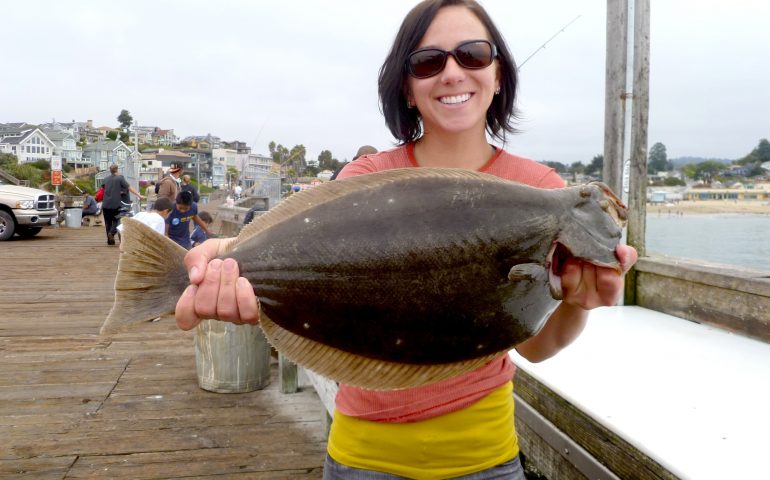
A good number of the larger listed halibut from decades past where caught by means of using a cigar shaped weight split ring and treble hook which was tossed and dragged across the sand actually snagging the halibut. This practice was outlawed several years ago yet a few less than ethical anglers still use the practice. Legally if you want halibut a great method is to use a lure that mimics a anchovy which is injured and fighting to survive kicking off the bottom. Zoom Fluke plastics with a light lead head 3/8ths to 1/2 ounce size can mimic a dying anchovy and its irresistible to halibut who may feed exclusively on anchovies . The plastics can also be loaded with a anchovy scent such as PRO-Cure gel which is pure concentrate bait fish. Halibut have superior smell which helps them find food in dirty or stained colored waters and a school of bait fish gives off natural oils which halibut can locate quite easily. The way to fish a plastic is toss the plastic to the bottom and twitch it two three times and let it settle back to the bottom. This will look like a dying anchovy which is struggling to survive and halibut will take every advantage . the leadhead rigged plastics also typically catch halibut in the mouth so shorts, ones less than 22 inches legal length in California can be released without a lot of damage. Baited hooks tend to cause deep liver wounds which are often fatal to a halibut and it becomes a free meal for a seal or shark . gut or liver hooked halibut which are short need to be released by cutting the line and sending back with minimal handling. Hooks can rust out and the halibut has a far greater chance to survive not attempting to dig the hook out but cheap anglers wont give up a hook!!! Working the lead head plastic is quicker often more effective and safer for juvenile halibut. Expect to pay about $4-5 for a pack of Zoom fluke and about a dollar to $1,50 a piece for the lead heads and a ounce bottle of pro cure runs about 8 dollars. Just a dab of pro cure is all you need so use sparingly. You also don’t need super heavy line for most pier halibut. #12-15 is plenty for a main line and #20 lb leader if the halibut are running big. Add a 3 ft section of the heavier leader with a strong small barrel swivel and the plastic can be attached by a small strong cross lock swivel making changing lures easy. Find the break line in the surf and start from there working the lure close to pilings and then expand out into the surf. Halibut love to hide around pilings in the dark and ambush feed but some will just lay in the open sand and wait for a meal. Work deeper repeating the process and when you get a bit just easily lift and let the halibut use its weight to set the hook verses ripping the lure . Halibut often just hold the lure softly and will re position the lure and a angler will rip the lure away to quickly. Lastly keep a pair of longer pliers ready to remove the lead head jig and if its embedded in a gill or liver by odd chance you should cut the shank of the lead head and let the halibut live. Last thing bring a large crab net ring with ample rope to reach the water line for landing and one with a soft netting verses that cheap plastic nets. These nets run about 30 bucks for a 48 inch ring. Put the net in the water first then guide the halibut in raise and lift over the rail. Takes a bit of practice but netting becomes easy over time and you will make a lot of friends by helping those who likely would lose their halibut without a one. .
Should also note that you should check out Calif piers carefully before traveling to as several are either closed, damaged or only partially open limiting access. Others have very controlling anglers where locals rule and you as a outsider to that crew will not be to welcome. I blame drug addicts who hang out on piers as a large cause of this and halibut are worth money so these meth head , coke heads and other scum will guard their pier fishing holes quite defensively. Best to just find a better location elsewhere and avoid getting into a conflict where your time in court and costs become expensive and infuriating as Calif wont crack down on this breed of scum. In many places these scum are given lots of free county help and they just live off the fish and panhandling as well or plain just ripping your gear off if they get a chance. Bad piers include Pacifia, Santa Cruz, Seacliff and Monterrey wharfs. Soc Cal piers have more year round halibut opportunities and while crowded at times you at least have some for of protection as the So cal piers are patrolled and typically have a lifeguard around if i issue occurs with a dickhead scumbag. Please report poachers to Cal tip and enjoy the halibut its a bonus for Calif anglers and should be cherished by all. .
I agree with some but also disagree with many of the above comments. In particular, I find the comparison between SoCal, CenCal and NorCal piers inaccurate. There are safe and unsafe piers no matter where you go, it’s part of the larger breakdown in society that is seen in many areas. I aslo disagree with the assertion that most of the big early halibut were caught by snagging. Instead, most of the early big halibut were caught because (1) more were around, and (2) many piers used to have live bait on the piers which dramatically increased the number of halibut being caught. The best example is probably the Redondo Beach Pier that USED to be a hot bed for halibut.